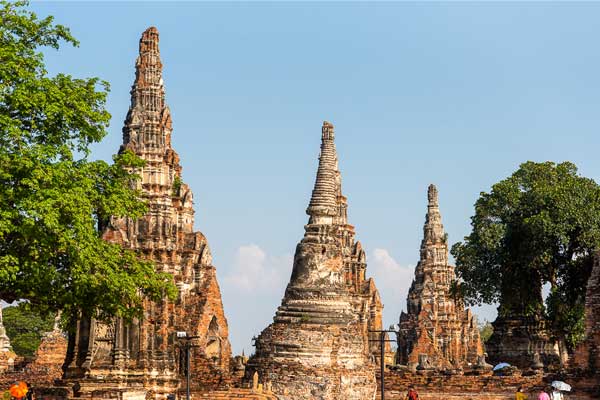Tuesday, July 5, 2022

Thailand’s former capital Ayutthaya is renowned for its temple ruins and historical sites. The UNESCO World Heritage Site was once the Siamese capital until 18th century.
There was an effort to recreate the urban model and architecture of Ayutthaya. Bangkok retains the official Thai name “Ayutthaya” as a part of its former title.
The city of Ayutthaya is dotted with historical statues, archeological ruins, temples, monasteries, souvenir shops, eateries and market places to allure tourists to rumble across its every nook and corner. Surrounded by these ruins, it’s not difficult to imagine the grandeur that once was the kingdom of Ayutthaya.
Its glorious history is reflected in different religious art and artefacts that date back to sometime between the 14th and 18th centuries.
Those with an interest in Thailand’s history should keep this ancient city in their bucket list.
The story behind
Ayutthaya was named after Ayodhya, the abode of Lord Rama who is the hero in the Ramayana.
The city of Ayutthaya was founded by King Uthong, a Chinese merchant in 1350 CE. He took such a path breaking decision when he shifted his court from Uthong to avoid an epidemic.
Through conquest, expansion, trade and commerce, Ayutthaya grew in size and power. Seeing it surpassed the erstwhile Thai capital city, Ayutthaya was declared the new capital by King Uthong before his death in 1369.
The city of Ayutthaya was attacked and burned to ashes in 1767 by the Burmese army. After its complete destruction, the capital was relocated to Bangkok.
Major landmarks in Ayutthaya
In Thai language, ‘wat’ denotes a Buddhist temple and monastery precinct, and Wat Chaiwatthanaram means “temple of victory and progress.” Located opposite the south-west corner of the historical island on the other side of the Chao Phra River lays Wat Chaiwatthanaram.
This Khmer-style temple is one among Ayutthaya’s most impressive temples which was built in 1630 during the reign of King Prasat Thong.
A boat ride to the temple offers stunning panoramic view at the backdrop of the sprawling monastery.
Wat Phra Si Sanphet
Wat Phra Sri Sanphet is located in Pratu Chai sub district, Phra Nakorn Si Ayutthaya district, Ayutthaya province. Situated within the Royal Palace grounds, Wat Phra Sri Sanphet is the royal monastery and therefore, no monk is allowed to reside at.
The Temple is not only a significant historical site, but also considered as the spiritual center of Thais for a long time.
In Ayutthaya’s heyday, this was the largest temple in the city. At the heart of the temple, there are three adjacent Ceylonese (or bell-shaped) pagodas situated on rectangular platforms.
The three main chedis which have been restored contain the ashes of three Ayutthaya kings.
Wat Phananchoeng
Wat Phanan Choeng is located on the banks of the Pa Sak River opposite to the South Eastern tip of the island.
The temple’s main attraction is its colossal gilded statue of Phra Chao Phanan Choeng in the traditional Mara or sitting posture. It has been a royal temple since ancient times and is a living monastery which follows the doctrine propagated by the Mara school of faith.
Legends have it, tears shed from the eyes of the image just before the destruction of Ayutthaya by the Burmese army in the year 1767. The ruins found in the vicinity reveal a deep spiritual ambiance associated with the place.
Wat Phra Ram
The impressive Khmer-style prang main building enshrines a staggering 57-feet tall, statue of Lord Buddha. It was founded shortly before Ayutthaya was established as the kingdom’s capital although no clear record of its founder has been deciphered.
It was formerly called “Phra Buddha Chao Phanan Choeng“, until King Rama IV renamed it “Phra Buddha Trirattana Nayok“.
Besides the iconic Buddha statue which is traditionally the major draw of Wat Phanan Choeng, one can marvel at the shrine of Chao mae Soi Dok Mak.
The monument clad in Chinese costume stands as an embodiment of Chinese architecture and widely worshipped by the Chinese.
Although the once eminent temple is in a dilapidating state, its eternal charm still portrays the glorious history of Thais.
Getting there
From Highway 309, the Chao Sam Phraya roundabout is the main intersection before you cross the bridge to the inner city. Continuing west of here, Highway 309 turns into Rochana Road, the main thoroughfare that cuts through the island from east to west.
From Rochana Road, turn right at Srisanphet Road, which soon turns into Naresuan Road, and you’ll find yourself inside Ayutthaya Historical Park. U-Thong Road encircles the inner city and runs parallel to the rivers.
If you don’t drive, it’s easy to get here from Bangkok by train, and hire a tuk-tuk from the train station to take you around the inner city. Negotiate a price for one-day or half-day hire and discuss all the sites you would like to visit with the driver before hopping on one.
Lots of local tour operators also offer a day tour from Bangkok to Ayutthaya, with many of them travelling one way by boat along Chao Phraya River and one way by car. There are many ruins and temples along the way so the cruise is usually relaxing.
To tour around Ayutthaya Historical Park, cycling is quite easy as the land is flat and the roads are well signed.
Image Copyright : APRATIM GHOSHAL
Editor, Travel And Tour World
Thursday, April 18, 2024
Friday, April 19, 2024
Friday, April 19, 2024
Friday, April 19, 2024
Thursday, April 18, 2024